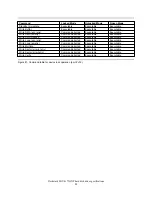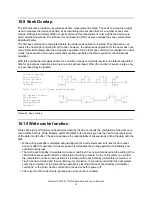
10.5.4 Interface capability for power modes
Each power mode affects the physical interface as defined in the following table.
Inactive
No
1
O
Sleep
Inactive
Yes
1
O
Standby
Active
Yes
1
O
Idle
Active
Yes
X
X
Active
Media
Interface
active
RDY
BSY
Mode
Figure 77. Power conditions
Ready (RDY) is not a power condition. A device may post ready at the interface even though the media
may not be accessible.
10.6 S.M.A.R.T. function
The intent of Self-Monitoring Analysis and Reporting Technology (S.M.A.R.T) is to protect user data and
prevent unscheduled system downtime that may be caused by predictable degradation and/or fault of the
device. By monitoring and storing critical performance and calibration parameters, S.M.A.R.T devices
employ sophisticated data analysis algorithms to predict the likelihood of near-term degradation or fault
condition. By alerting the host system of a negative reliability status condition, the host system can warn
the user of the impending risk of a data loss and advise the user of appropriate action.
10.6.1 Attributes
Attributes are the specific performance or calibration parameters that are used in analyzing the status of
the device. Attributes are selected by the device manufacturer based on the ability of that attribute to
contribute to the prediction of degrading or faulty conditions for that particular device. The specific set of
attributes being used and the identity of these attributes is vendor specific and proprietary.
10.6.2 Attribute values
Attribute values are used to represent the relative reliability of individual performance or calibration attri-
butes. The valid range of attribute values is from 1 to 253 decimal. Higher attribute values indicate that
the analysis algorithms being used by the device are predicting a lower probability of a degrading or faulty
condition existing. Accordingly, lower attribute values indicate that the analysis algorithms being used by
the device are predicting a higher probability of a degrading or faulty condition.
10.6.3 Attribute thresholds
Each attribute value has a corresponding attribute threshold limit which is used for direct comparison to
the attribute value to indicate the existence of a degrading or faulty condition. The numerical values of the
attribute thresholds are determined by the device manufacturer through design and reliability testing and
analysis. Each attribute threshold represents the lowest limit to which its corresponding attribute value
can be equal while still retaining a positive reliability status. Attribute thresholds are set at the device
manufacturer's factory and cannot be changed in the field. The valid range for attribute thresholds is from
1 through 253 decimals.
Deskstar 40GV & 75GXP hard disk drive specifications
81
Summary of Contents for DTLA-305040 - Deskstar 41.1 GB Hard Drive
Page 8: ...This page intentionally left blank...
Page 16: ...This page intentionally left blank...
Page 17: ...Part 1 Functional specification Deskstar 40GV 75GXP hard disk drive specifications 5...
Page 18: ...This page intentionally left blank...
Page 20: ...This page intentionally left blank...
Page 30: ...This page intentionally left blank...
Page 32: ...This page intentionally left blank...
Page 34: ...This page intentionally left blank...
Page 76: ...This page intentionally left blank...
Page 77: ...Part 2 Interface specification Deskstar 40GV 75GXP hard disk drive specifications 65...
Page 78: ...This page intentionally left blank...
Page 80: ...This page intentionally left blank...
Page 108: ...This page intentionally left blank...
Page 116: ...This page intentionally left blank...
Page 206: ...This page intentionally left blank...
Page 210: ...This page intentionally left blank...
















































